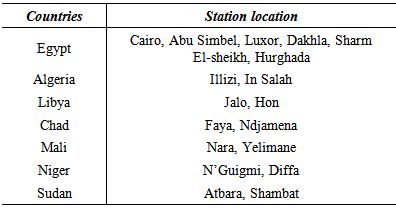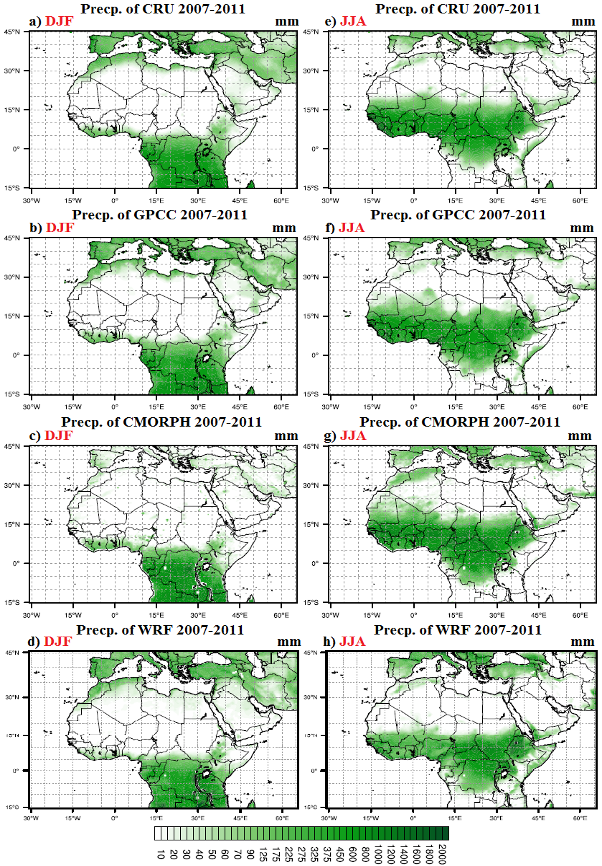-
Paper Information
- Paper Submission
-
Journal Information
- About This Journal
- Editorial Board
- Current Issue
- Archive
- Author Guidelines
- Contact Us
World Environment
p-ISSN: 2163-1573 e-ISSN: 2163-1581
2015; 5(4): 160-173
doi:10.5923/j.env.20150504.04
Regional Climate Simulation of WRF Model over North Africa: Temperature and Precipitation
A. A. Abdallah1, M. M. Eid1, M. M. Abdel Wahab2, F. M. El-Hussainy1
1Astronomy and Meteorology Department, Faculty of Science, Al-Azhar University, Cairo, Egypt
2Astronomy and Meteorology Department, Faculty of Science, Cairo University, Giza, Egypt
Correspondence to: A. A. Abdallah, Astronomy and Meteorology Department, Faculty of Science, Al-Azhar University, Cairo, Egypt.
| Email: |  |
Copyright © 2015 Scientific & Academic Publishing. All Rights Reserved.
Regional climate models are commonly used to provide detailed information on climatic conditions at local or regional scale. This work presents evaluation of the first simulation (temperature and precipitation) of a series of climate simulations (dust and aerosols climate simulations) with WRF (Weather Research and Forecasting) model over a large domain covering most of the African continent. The 5.5 years simulations (July 2006-December 2011) have been compared with gridded observational datasets (CRU, GPCC) and gridded satellite dataset (CMORPH) for several variables, including seasonal precipitation, mean, maximum and minimum 2-meter air temperature. The regional climate model reproduces the observed spatial distribution of temperature well; with a cold bias model simulation along with the study period over most African continent for mean, maximum and minimum temperatures, while warm bias appears in minimum temperatures. For precipitation the WRF model reproduces well the rain belt and precipitation distributions in DJF and JJA seasons, while was slightly incapability in simulation in MAM and SON.
Keywords: WRF, Regional Climate Simulation, North Africa, Temperature 2m and Precipitation
Cite this paper: A. A. Abdallah, M. M. Eid, M. M. Abdel Wahab, F. M. El-Hussainy, Regional Climate Simulation of WRF Model over North Africa: Temperature and Precipitation, World Environment, Vol. 5 No. 4, 2015, pp. 160-173. doi: 10.5923/j.env.20150504.04.
Article Outline
1. Introduction
- Regional Climate Models (RCMs) have been widely applied and well recognized as an essential tool to address scientific issues concerning of climate variability, changes, and impacts at regional–local scales [1-9]. Numerous RCMs have been developed and applied for simulating the present climate in the worldwide locations. The performance of the RCMs to successfully reproduce the observed regional climate characteristics within the last decades was extensively assessed.Recently, WRF model has been increasingly used as RCM for the most applications of downscaling, climate simulations, and parameterizations studies. In this work, the climate simulation is carried out with the regional climate WRF model version 3.5 (NCAR Weather Research & Forecasting Model, USA) [10]. This work will focus on the accuracy of the WRF model to successfully reproduce the observed regional climate characteristics of temperature and precipitation over a large domain covering most of the African continent, especially North Africa. Northern Africa is characterized by a Mediterranean climate at the north coast and a large desert area in the south, where temperatures are the hottest [11]. According to global climate projections [12], the already environmentally stressed Middle East and North Africa region will be one of the most prominent climate change hotspots. Substantial decreases in precipitation, especially during the winter season and intense warming, most pronounced during summer, will probably have strong economic and societal impacts in the region [13]. The aim of this work is to examine the capability of the WRF model to simulate temperature and precipitation over North Africa and it’s validation with available observed datasets. In general, this work is the first simulation (temperature and precipitation) of a series of climate simulations over North Africa, the second simulation is a climate dust simulation, and the third is a climate aerosols simulation.
2. Model, Data and Experimental Design
2.1. Regional Climate Model
- The CLWRF [14] set of modifications, implemented in the version 3.5 of WRF model, was used for the simulations of this study, the WRF model is an advanced mesoscale numerical weather prediction system designed to serve both operational forecasting and atmospheric research needs (http://www.wrfmodel.org). The version 3.5 of WRF model was used for the simulation of this study. The physics options used in this study include the Lin et al. Microphysics scheme [15], Kain–Fritsch convective parameterization scheme [16], CAM Shortwave and Longwave schemes [17], the Yonsei University planetary boundary layer scheme [18], the Noah Land Surface Model (LSM) four-layer soil temperature and moisture model with canopy moisture and snow-cover prediction [19] and MM5 Similarity Surface Layer Scheme [20-24]. A summary of the selected model physics options is given in Table 1. The extent of the North Africa domain is presented in Fig. 1, while the length of the simulation is 5.5 years (July 2006-December 2011), in addition to five months of spin-up time (July-November 2006) which was excluded from our analysis. We have used a horizontal resolution of 50 km and 51 vertical levels. The NCEP/DOE reanalysis-2 dataset was used to provide initial and boundary conditions, and covered the most African continent (including the North Africa interior domain). The output is stored every 6 h (00, 06, 12, 18 UTC) and monthly fields are there from derived. In our study, we evaluate the performance of the WRF model with globally available observations of temperature 2m (Mean T2m, Minimum T2mn, and Maximum T2mx) and precipitation.
|
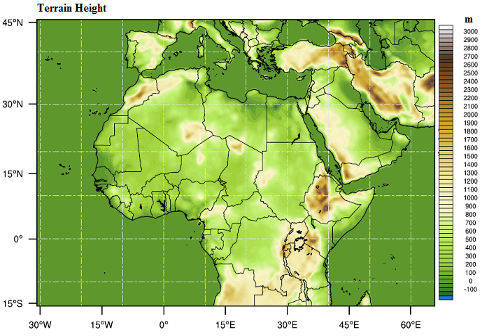 | Figure 1. Terrain height of model domain over African continent with a 50-km resolution grid |
2.2. Data Forcing
- The reanalysis data that provide the initial and lateral boundary conditions to the regional climate WRF model in this study is the NCEP/DOE Reanalysis-2 global data [25]. This data was created in cooperation between the National Centers for Environmental Prediction (NCEP) and Department of Energy (DOE). NCEP/DOE Reanalysis-2 is an improved version of the NCEP Reanalysis-1 model that fixed errors and updated parameterizations of physical processes. The NCEP/DOE Reanalysis-2 data are split into 2D and 3D files, the 2D data has T63 horizontal spectral resolution (1.875 × 1.875 degrees) while 3D has horizontal spectral resolution (2.5 × 2.5 degrees), the temporal coverage is 4-times daily and monthly values, and 17 vertical levels, with the top extending to 10 hPa. The global SST data used has weekly of temporal coverage and (1 × 1 degrees) horizontal resolution and updated in the model every 6 hr.
2.3. Observational Datasets
- Surface meteorological variables extracted from the model output were compared with the CRU and GPCC gridded datasets and CMORPH from satellite gridded dataset. The Climatic Research Unit Timeseries (CRU TS) datasets contain monthly time series of precipitation, daily maximum and minimum temperatures, cloud cover, and other variables covering Earth's land areas, the CRU version used is CRU TS3.21, 2013 [26] [27] and available through the Climatic Research Unit at the University of East Anglia. The dataset is gridded to 0.5x0.5 degree resolution, based on analysis of over 4000 individual weather station records distributed around the world. The Global Precipitation Climatology Centre (GPCC) [28] dataset has been established in 1989 on request of the World Meteorological Organization (WMO). It is operated by Deutscher Wetterdienst (DWD, National Meteorological Service of Germany) as a German contribution to the World Climate Research Programme (WCRP). The GPCC’s new global precipitation climatology V.2015 is available in 0.5° x 0.5° resolution based on data from ca. 75,000 stations is used as background climatology for the other GPCC analyses.The CMORPH (CPC MORPHing technique) produces global precipitation analyses at very high spatial and temporal resolution [29] [30] [31] [32]. This technique uses precipitation estimates that have been derived from low orbiter satellite microwave observations exclusively, and whose features are transported via spatial propagation information that is obtained entirely from geostationary satellite IR data. The CMORPH data has a spatial resolution of 0.5° x 0.5° and 3-hourly temporal resolution. The comparison focused on mean seasonal of (T2m), maximum (T2mx), minimum (T2mn) temperature and precipitation in order to attribute some of the surface variables biases. Moreover, monthly observations derived from the CRU dataset were used for 18 selected locations over the desert area in North Africa domain for the trends of mean T2m. The choice of stations was based on the hottest places in the domain for the period of interest and the spread of stations across the region. Table 2 shows the stations location in their countries.
|
3. Results
- In this section the model temperature outputs are compared with the CRU observation dataset while the precipitation is compared with CRU, GPCC and CMPRPH datasets for the study period.
3.1. Temperature Fields
3.1.1. Mean Temperature T2m
- The mean T2m of the CRU data for the study period is presented in the top left panel of Fig. 2 as a reference, the top right panel for the WRF model and the bottom panel for the bias during the study period. It is clear from the bias map in Fig. 2.c that the cold bias in the model simulation along with the study period was over most African continent while the warm bias was over the Morocco, Northern of Algeria, Chad, Ethiopia and Kenya.
 | Figure 2. The mean T2m temperature of CRU in top left panel (a), WRF in top right panel (b) and the bias map (WRF minus Observations) in bottom panel (c) during the study period (2007-2011) |
 | Figure 3. The biases (WRF minus observations) of seasonal T2m during the study period (2007-2011) |
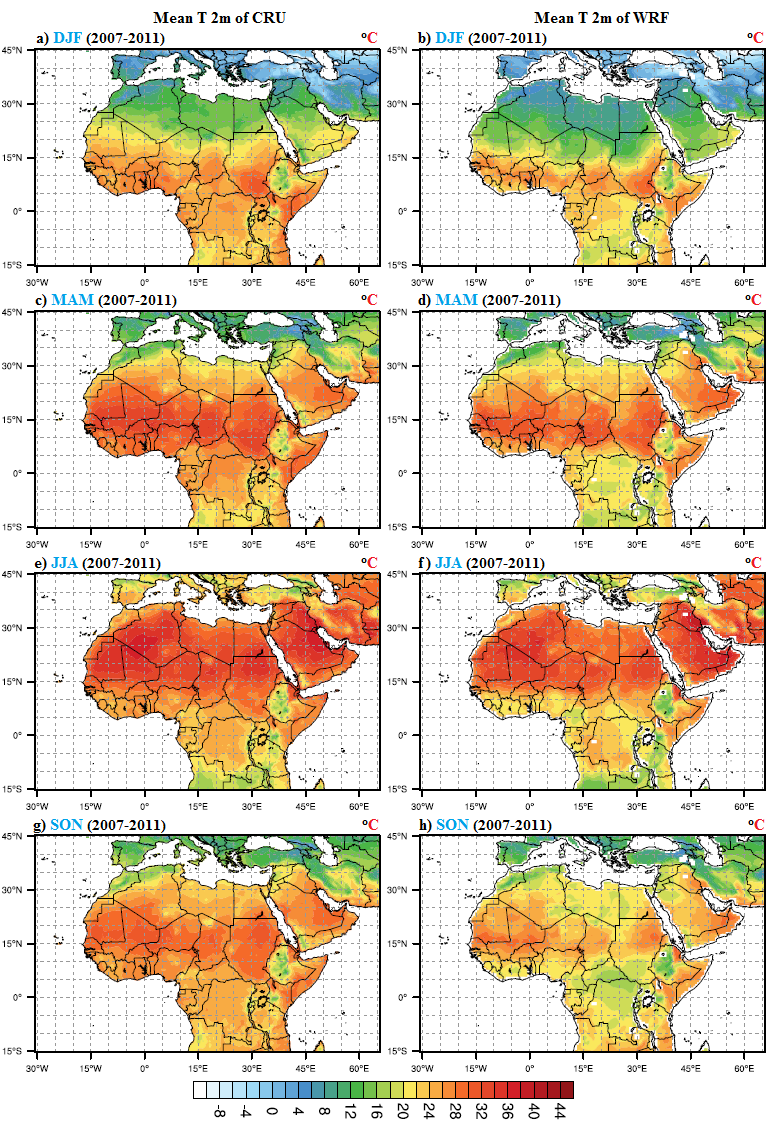 | Figure 4. The seasonal mean of T2m from CRU gridded analysis in the left panel for (a, c, e and g) and WRF model in the right panel for (b, d, f and h) during the study period (2007-2011) |
3.1.2. Stations Comparison
- A comparison between WRF model simulation and the CRU observed data was performed over 18 station locations (Table 2) in the desert area (hottest area) over the study domain. The closest model land grid point to the stations coordinates is considered with the mean T2m of the closest CRU grid point for the comparisons. As shown in Figs. 5, 6 and 7, the 18 stations divided over 7 countries, Fig. 5 represent six stations over Egypt due to importance of this area in the second simulation (dust simulation), Fig. 6 has two stations over Algeria, two stations over Chad and two stations over Libya, Fig. 7 has two stations over Mali, two stations over Niger and the last two over the Sudan area.
 | Figure 5. The time series of the mean T2m of six stations over Egypt |
 | Figure 6. The time series of the mean T2m of Two stations for each of the Algeria, Chad and Libya |
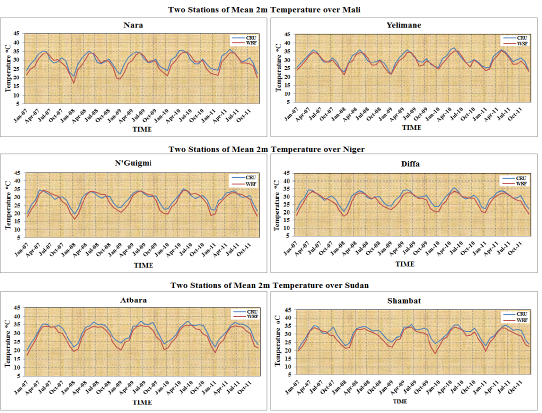 | Figure 7. The time series of the mean T2m of Two stations for each of the Mali, Niger and Sudan |
3.1.3. Mean Maximum Temperature T2mx
- As shown in Fig. 8 for the biases maps, the DJF bias (Fig. 8a) shows strong cold bias over the north band of domain especially over the northern of Sudan area. The MAM bias (Fig. 8b) shows the cold bias appears over the south band of domain, while the warm bias appears in the south coast of Mediterranean sea, the west coast of the Red Sea, Ethiopia, and over the small parts in West Africa. The JJA bias (Fig. 8c) shows the most of cold bias appears over north band of domain, while the warm bias appears over the southern of Morocco and small parts over the south band. The SON bias (Fig. 8d) shows the warm bias appears over the northern of Libya, Algeria and Morocco, while the cold bias is concentrated over the southern of Sudan area.
 | Figure 8. The biases (WRF minus observations) of maximum T2mx during the study period (2007-2011) |
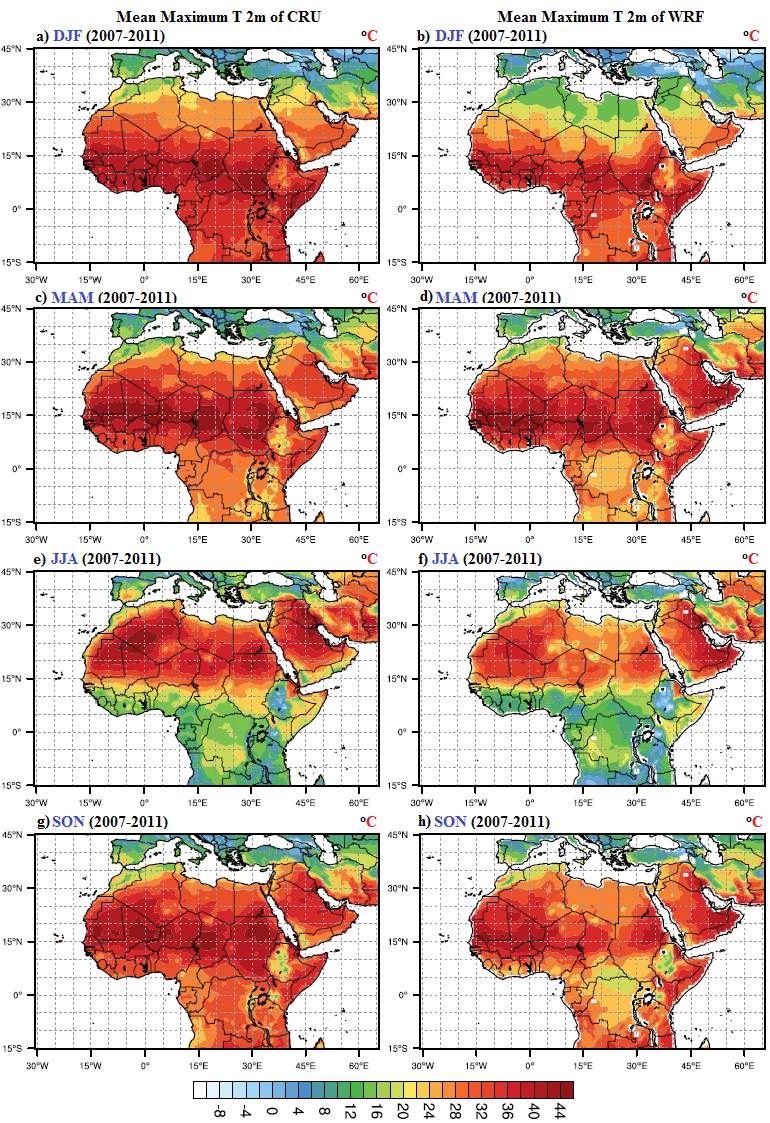 | Figure 9. The seasonal mean of T2mx from CRU gridded analysis in the left panel for (a, c, e and g) and WRF model in the right panel for (b, d, f and h) during the study period (2007-2011) |
3.1.4. Mean Minimum Temperature T2mn
- As shown in Fig. 10 for the biases maps, in DJF bias (Fig. 10a) the cold bias appears in north and south bands of the domain, while the warm bias appears in the middle band. In MAM bias (Fig. 10b), the warm bias appears over the north band while the cold bias appears over the south band of the domain. In JJA bias (Fig. 10c), the warm bias appears in the north and south bands of the domain, while the cold bias appears in the middle band. In SON bias (Fig. 10d), the cold bias is located over most Africa continent, while the warm bias over the northern of Algeria, Morocco and Ethiopia.
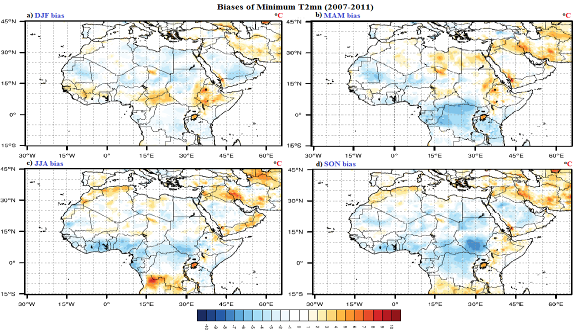 | Figure 10. The biases (WRF minus observations) of minimum T2mn during the study period (2007-2011) |
 | Figure 11. The seasonal mean of T2mn from CRU gridded analysis in the left panel for (a, c, e and g) and WRF model in the right panel for (b, d, f and h) during the study period (2007-2011) |
3.2. Precipitation Fields
- WRF-simulated for the spatial patterns of the seasonal precipitation over the study period are compared to those from CRU, GPCC and CMORPH datasets for DJF in Fig. 12a, b, c and d, JJA in Fig. 12e, f, g and h, MAM in Fig. 13a, b, c and d and SON in Fig. 13e, f, g and h. As most of the African continent lies within the tropics, the seasonal migration of the tropical rainbelt that regulates the alternation of wet and dry seasons is the principal characteristic of precipitation over the Africa continent. Furthermore, small shifts in the position of the rainbelt can result in large local changes in precipitation; this has a direct impact upon water resources and agriculture in the semiarid regions of the continent, such as the Sahel. There are also regions on the northern and southern limits of the continent with winter rainfall regimes that are governed by the passage of mid-latitude fronts. The wettest regions in Africa are those of the equatorial, tropical rainforest climate type, where there is rain throughout the year, with two peak periods corresponding to the double passage of the tropical rainbelt. The driest regions are those of the desert climate type, such as those of the Sahara, Kalahari and Somali deserts, where there is very little precipitation [45].
4. Conclusions and Future Plans
- While Numerous RCMs have been developed and applied for simulating the present climate in the worldwide locations, we used the climate version of WRF model to conduct a series of climate simulations over North African domain. These simulations are climate simulation, climate dust simulation, and climate aerosols simulation.We have presented results of 5.5 years simulation by the WRF model in climate mode. The WRF simulation succeeds in reproducing the main geographical distribution and seasonal variations of temperatures, although some biases are apparent. Model temperature is mostly underestimation from the observational data along with the simulation period. The location and timing of the tropical rain belt is well reproduced, as well as the seasonal precipitation cycle. The apparent of cold biases is due to the overestimation of WRF clouds over the domain of study, where the model has uncertainty in the simulation of clouds.The future plan including a dust and aerosols simulations, will conduct using WRF model in climate mode for the same period and physics configuration.
 Abstract
Abstract Reference
Reference Full-Text PDF
Full-Text PDF Full-text HTML
Full-text HTML
